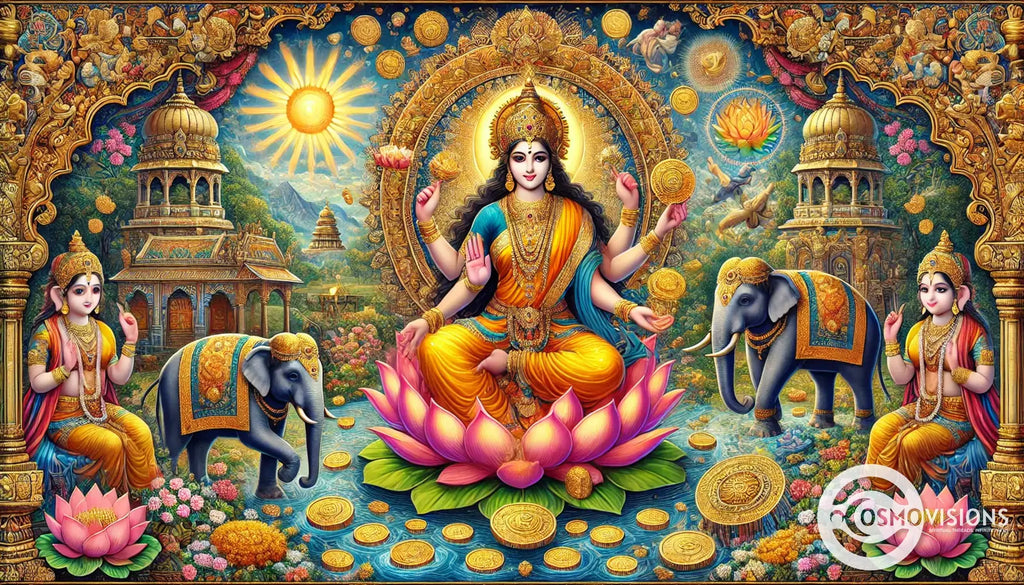Hindu Goddess Lakshmi - Goddess of Wealth and Prosperity
Posted by Massimiliano Geraci

In life, the quest for wealth and prosperity often leads us down various paths. Some find success in their pursuits, others face challenges that seem insurmountable. Amidst these journeys, the spiritual significance of God Lakshmi offers a beacon of hope and guidance.
Known as the Hindu goddess of wealth and prosperity, her presence is sought after by many desiring abundance in life.
Goddess Lakshimi's origins are deeply rooted in Hindu mythology, where she emerges as a symbol of fortune, power, and beauty. This article explores how worshiping Goddess Lakshmi can attract positive energy into our lives.
From ancient rituals to modern celebrations like Diwali - the festival of lights - we uncover practices that invite Lakshmi's blessings into homes and hearts. Discover how this deity's grace can inspire good fortune and overall well-being.
Read on to illuminate your path with prosperity.
Who is Goddess Lakshmi?
Goddess Lakshmi, revered as the deity of wealth, fortune, and prosperity in Hinduism, embodies both material riches and spiritual success. She is often depicted as beautiful goddess seated on a lotus flower, symbolizing purity despite the challenges in life, and holds a pot of gold to represent financial abundance.
This goddess ensures her devotees' well-being and also guides them to the path of righteousness and dharma. Her four hands signify the objectives every human being strives for: Dharma (righteousness), Artha (wealth), Kama (desires), and Moksha (liberation from cycles of death and rebirth).
The tales surrounding Lakshmi's origins are vast; she emerged from the ocean of milk during Samudra Manthana, clad in white with gold cascading around her luminous presence. As Vishnu's consort, she plays a crucial role in maintaining cosmic balance by mediating between gods and demons to ensure harmony prevails.
Worshiping Shri Lakshmi transcends seeking material gains—it invites grace into one’s life for inner peace that radiates outwardly.
Lakshmi personifies hope—that good over evil prevails when supported by strength gathered through unity.

Origins and Myths Surrounding Goddess Lakshmi
Lakshmi, often called the goddess of wealth and prosperity, has her origins steeped in ancient Hindu mythology. Legends recount that she emerged from the Kshira Sagara (Ocean of Milk) during the churning of the cosmic ocean, a pivotal event known as Samudra Manthan.
This celestial occurrence involved gods and demons working together to obtain amrita, the elixir of immortality. Lakshmi chose Vishnu as her consort at this time, symbolizing eternal companionship.
Her arrival is celebrated during Diwali, marking victory over darkness and ignorance.
Her significance transcends material wealth to encompass spiritual abundance, making her an integral deity in Hinduism. Various texts mention Lakshmi's manifestations or avatars like Sita with Lord Rama and Rukmini with Krishna — each embodying virtues such as devotion and purity.
In artwork across India, she is depicted standing on a lotus flower or seated beside Vishnu underlining her association with fertility, beauty, and auspiciousness. The festival Gaja Lakshmi Puja highlights another aspect where she is seen flanked by elephants' symbols of royal power yet another reflection of her diverse attributes meeting earthly needs while guiding devotees to spiritual enlightenment.
Importance of Lakshmi in Hinduism
In Hinduism, the goddess Lakshmi embodies wealth, prosperity, and good fortune. Her significance stretches beyond material riches to include spiritual abundance and well-being. Devotees seek her blessings for both immediate financial gain and long-lasting happiness, making her worship central to achieving a balanced life that harmonizes material and spiritual goals.
This dual aspect of Lakshmi's influence reflects the Hindu belief in a coherent universe where worldly success and spiritual enlightenment are not mutually exclusive but interdependent.
Worship of Lakshmi, often in conjunction with Vishnu, serves as a reminder that prosperity can bloom even in challenging circumstances if one adheres to dharma (righteous living). During festivals such as Diwali—the victory of light over darkness—Lakshmi Puja is performed in millions of homes, inviting the goddess into their lives for blessings of wealth and well-being.
As the consort of Lord Vishnu, she also plays a crucial role in maintaining cosmic order, further highlighting her importance across various levels of Hindu cosmology from household rituals to grand cosmic principles.
Through symbols like the pink lotus flower and incarnations such as Gaja Lakshmi or Ashta Lakshmi, devotees recognize her manifold attributes contributing to an enriched life experience filled with grace and abundance.
Incarnations of Lakshmi
Lakshmi, the goddess of wealth, prosperity, and fortune, manifests through various incarnations that embody her divine qualities. Each incarnation represents different aspects of life and spiritual ideals.
For instance, Adi Lakshmi symbolizes eternal peace and prosperity, while Dhanya Lakshmi stands for agricultural abundance and nourishment. Similarly, Gaja Lakshmi brings good luck and is often depicted with elephants to signify her royal power.
Manifestations like Veera Lakshmi reflect courage and strength in overcoming obstacles. Through these incarnations, worshippers seek divine blessing for a variety of life’s facets from material riches to inner strength.
Devotees believe invoking specific forms of Lakshmi during rituals attracts the corresponding form of energy or grace into their lives.
In each avatar, Lakshmi offers unique gifts that span from material bounty to spiritual liberation.
These diverse embodiments highlight how Hindus honor the multifaceted nature of divinity and prosperity as detailed in Lakshmi Tantra. Worship practices adjust according to the desired aspect of Lakshmi’s grace sought by devotees, guided by the teachings of Lakshmi Tantra.

How is Goddess Lakshmi Worshipped?
Devotees honor Goddess Lakshmi through intricate rituals and customs, highlighting her significance as the deity of wealth, fortune, and prosperity. These ceremonies often commence with a thorough cleaning of homes and places of worship, symbolizing purification before inviting the hindu goddesses into their midst.
The sacred act involves lighting lamps to fend off darkness and evil spirits, embodying the victory of good over evil—a core principle during the festival of Diwali. During this time, worshippers partake in Lakshmi Puja, an autumn celebration that sees millions invoking the goddess for blessings.
Mantras play a crucial role in worship practices dedicated to Lakshmi. Chanting specific verses believed to appease the goddess forms an integral part of these prayers. On Diwali night, families gather together to recite slokas from ancient scriptures such as the Vedas that praise Devi Lakshmi’s virtues—wealth, courage, fertility—and seek her grace for prosperity and good fortune.
The mantra "Shri", symbolizing ultimate respect towards her divine energy, is fervently uttered to capture her attention and earn her favor. Through these spiritual expressions rooted deep in Hindu tradition—via puja rituals or mantras—devotees aim to draw closer to Lakshmi’s benevolence throughout significant religious observances like Diwali or regular worship sessions at hindu temples adorned with symbols like lotus flowers representing purity and beauty akin to that of the goddess herself.
Rituals and Customs in Lakshmi Puja
Lakshmi Puja forms a cornerstone of spiritual observance for Hindu devotees, marking an epitome of reverence towards the goddess of wealth and prosperity. This ceremony, embedded in tradition and rich symbolism, encapsulates the collective hopes for well-being and affluence within its ritualistic framework.
1. Preparation starts with cleaning homes thoroughly to invite Lakshmi into their dwellings - a physical manifestation of the internal desire for purity and prosperity.
2. Devotees adorn their Puja rooms with images or sculptures of Lakshmi and Vishnu, acknowledging their inseparable bond and eternal companionship, just as Lakshmi adorns Vishnu with her presence and grace.
3. A special altar is set up with Nelumbo nucifera (the sacred lotus), symbolizing beauty, fertility, prosperity, spirituality, and eternity – all attributes associated with Lakshmi.
4. Offerings of sweets, fruits, and flowers are laid out on the altar as a gesture of devotion and to seek blessings from the goddess.
5. The iconic step involves lighting oil lamps around the home evening to ward off shadows and invite divine energy reminiscent of Diwali's illumination.
6. Recitation of mantras such as "Shri Sukta," a powerful hymn from the Vedas dedicated to Lakshmi, forms an integral part of the rituals emphasizing spirituality over material gains.
7. Participants place coins in front of Lakshmi's idol or picture as symbols of wealth she governs while seeking her blessings for financial stability.
8. Drawing small footprints using rice flour at the house entrance represents welcoming Lakshmi into one’s home, signifying auspiciousness and fortune arrival.
9. Engagement in Bhakti (devotion) through singing hymns and chants glorifies Lakshmi’s virtues, embodying desires for harmony within households.
10. Concluding prayers involve personal requests whispered to Lakshmi’s ears by each family member - a poignant reminder that prosperity blooms under her benevolent gaze amidst good or bad circumstances.
Through these carefully crafted rituals steeped in ancient traditions, followers transcend mere pleading for earthly riches; they start on a spiritual journey towards understanding wealth's transient nature under Lakshmi’s watchful eyes.
The Role of Mantras in Worshipping Lakshmi
Moving from the general rituals and customs in Lakshmi Puja, mantras play a pivotal role in connecting devotees with the divine essence of Goddess Lakshmi. These sacred utterances, deeply rooted in Sanskrit, are chanted to invoke the goddess's blessings for wealth, prosperity, and well-being.
Practitioners believe that each mantra resonates with cosmic energy, creating a spiritual bridge between the worshipper and Lakshmi. The most popular among these is the Sri Suktam, an ode dedicated to invoking her abundant grace.
It encompasses rich imagery from nature and Vedic philosophy, symbolizing fertility, prosperity, and the bounty of the earth.
Devotees often recite specific mantras during puja rituals to welcome Lakshimi into their homes and hearts with hope for good fortune. Each mantra holds its unique vibration; chanting it requires focused intention to tap into its potent energies effectively.
For instance, "Om Shreem Mahalakshmiyei Namaha" is frequently chanted to attract wealth and clear obstacles blocking abundance paths. This practice embodies a profound act of devotion that transcends mere words—turning recitations into offerings that honor both goddess Lakshmi’s omnipresence and generosity.
Mantra chanting transforms ordinary syllables into sacred acts of devotion.
Diwali: The Festival of Lights and Lakshmi Worship
Transitioning from the significant role of mantras in worshipping Lakshmi, we delve into Diwali, a paramount Hindu festival that celebrates both the triumph of light over darkness and the goddess of wealth and prosperity, Lakshmi.
Known as the Festival of Lights, autumn festival celebrated Diwali sees millions worldwide illuminating their homes with lamps and candles. This act symbolizes inviting Lakshmi into their dwellings to bless them with wealth and good fortune.
During this auspicious time, devotees perform Lakshmi Puja with great reverence and joy. They place oil lamps around their houses on moonless nights—believed to be when Lakshmi roams the earth—hoping to attract her attention for blessings.
The worship involves offering flowers, sweets, foods prepared for the occasion—their aroma mingling with that of incense sticks burned in honor—and reciting prayers dedicated to ushering in prosperity.
It's a vivid tableau where culture intertwines deeply with spirituality under kaunmudi (moonlight), reinforcing bonds within communities celebrating together across continents—from India reaching corners far beyond its borders.

What Symbolizes the Presence of Lakshmi?
The lotus flower, known as "Padma" in sacred texts, stands as a powerful symbol for Goddess Lakshmi. This emblem represents beauty and purity emerging from murky waters, mirroring wealth and prosperity arising from the challenges of life.
The Sacred Lotus's association with Goddess Lakshmi highlights her role in bringing about fertility, love, and eternal bliss amidst worldly turmoil. Common symbols accompanying Lakshmi include gold coins flowing from her hands, signifying infinite wealth; the elephant or ‘Gaja,’ symbolizing royal power; and the auspicious ‘Shankha,’ or conch shell, denoting the spread of divine sound.
Lakshmi’s four hands reflect the objectives of human life according to Hindu philosophy: Dharma (righteousness), Artha (wealth), Kama (desire), and Moksha (liberation). Each hand holds an item – a lotus flower, a pot of gold, a book, and a garland – which together convey her ability to grant both material riches and spiritual wisdom.
These attributes make Lakshmi not the goddess of fortune but also a mediator between wealth and enlightenment. As we explore her diverse manifestations like Gaja Lakshmi showing royal authority or Veera Lakshmi representing valor in overcoming obstacles for prosperity's sake, their inherent symbolism serves as reminders that good fortune is multifaceted.
Transitioning into understanding how these symbols manifest across different forms offers deeper insight into Lakshmi’s extensive influence within Hinduism.
The Lotus Flower and its Significance
Sacred lotus, or Padma as known in Hindu tradition, carries profound symbolic weight and is often depicted with deities such as Lakshmi and Vishnu. Its growth from the murky waters to bloom into a beautiful flower epitomizes purity, enlightenment, and rebirth.
For Hindu goddess Lakshmi, the lotus signifies not just purity but also beauty and prosperity. It embodies her unblemished nature and the wealth that she bestows upon those who worship her.
In religious art, the imagery of Lakshmi seated on a lotus flower represents stability amidst chaos—echoing the belief that good and prosperity can bloom even in trying conditions.
This visual metaphor extends to teachings within Hindu scriptures where Padma symbolizes spiritual knowledge outshining ignorance."Good fortune lies within your spirit's journey toward enlightenment.
Common Symbols Associated with Lakshmi
The lotus flower, emerging in purity and enlightenment from murky waters, profoundly symbolizes Lakshmi's promise of wealth and fortune. This sacred blossom represents the goddess's unblemished nature and her power to bestow prosperity on those who seek her blessings.
Coins frequently accompany depictions of Lakshmi, cascading from her hands to denote endless wealth flowing from the divine to humanity. These coins, often gold, underscore the abundance that Lakshmi can provide to devout followers.
Elephants flanking Goddess Lakshmi signify royal power and rain-bearing clouds essential for a prosperous harvest, aligning with agricultural bounty as another aspect of wealth. The depiction offers a vivid reminder of fertility and abundance under her auspice.
Moreover, Sudarshana Chakra appears beside or in the hand of some representations of Lakshmi; this disc weapon is a token of protection against misfortune and an emblematic connection to Vishnu, reinforcing their eternal bond and combined efforts to maintain cosmic balance.
Through these symbols - lotus flowers, coins, elephants, and the Sudarshana Chakra - devotees visually grasp the multifaceted nature of Lakshmi’s benevolence: spiritual purity, material success, protective might, and life-sustaining resources.
Four Hands and Their Meanings
Following the exploration of common symbols associated with Lakshmi, it is integral to explore the significance of her four hands, which embody the spiritual values and aspirations she represents.
Each hand symbolizes a different aspect of human life and spirituality that Lakshmi influences. In one hand, Lakshmi holds a lotus or Padma, illustrating purity and devotion amidst life’s challenges.
Another hand gestures Abhaya Mudra, signifying the goddess's protection from fear and granting blessings for peace.
Her second pair of hands exhibit Varada Mudra, indicating her power to grant wishes and prosperity to her devotees. This gesture connects deeply with those seeking wealth and fortune under her benevolence.
One more hand often showcases gold coins flowing from it, symbolizing material wealth being bestowed upon humanity by Lakshmi. Through these articulations captured in sacred lotus reliquary art forms across Hindu deities' portrayals including Vishnu's consort Shri Lakshmi’s iconography; adherents are reminded constantly of their pursuits: dharma (righteousness), artha (wealth), kama (desire), and moksha (liberation) - collectively known as the four goals prescribed by Hindu philosophy for a fulfilled life.
What Are the Different Forms of Lakshmi?
Lakshmi embodies wealth, fortune, and prosperity in Hinduism. She manifests in several forms to denote different aspects of life and spiritual well-being. Ashta Lakshmi represents eight distinct manifestations of the goddess, each signifying different forms of wealth and fortune.
These include Dhana Lakshmi for material wealth, Vidya Lakshmi for knowledge, and Gaja Lakshmi for power and strength, highlighting her multifaceted nature as a deity.
Apart from Ashta Lakshmi, other notable forms include Gaja Lakshmi, who is often depicted with elephants—a symbol of royal power and assured success in Hindu culture. Veera Lakshmi stands for valor and courage in adversity while Dhanya Lakshmi symbolizes agricultural bounty.
Each form captures a unique aspect of human aspiration towards prosperity, wisdom, energy (Shakti), courage (Veera), or bountiful resources (Dhanya). Worshipers seek blessings from these various embodiments during rituals like Gaja Lakshmi Puja to invite abundance into their lives.
Ashta Lakshmi: The Eight Distinct Manifestations
Ashta Lakshmi refers to the eight distinct manifestations of Goddess Lakshmi, each embodying a specific aspect of wealth and prosperity crucial in Hinduism. Each form stands as a testament to the multifaceted nature of well-being and abundance, ranging from material riches to spiritual enlightenment.
1. Adi Lakshmi, or Maha Lakshmi, the supreme goddess symbolizes the primary source of prosperity and eternal wealth. As the mother goddess, she represents the boundless wealth of nature and spiritual nirvana.
2. Dhanya Lakshmi brings agricultural wealth and abundance in grains. She ensures that households never face scarcity and are always blessed with food.
3. Dhairya Lakshmi represents courage and strength. This form aids devotees in overcoming obstacles and hardships, ensuring progress on their paths.
4. Gaja Lakshmi is associated with royal splendor and the power of sovereignty, often depicted with elephants—a sign of good fortune and magnificence in Hindu mythology.
5. Santana Lakshmi blesses families with progeny, ensuring the continuity of lineage and family heritage. She embodies fertility and the richness of life.
6. Vidya Lakshmi grants wisdom, knowledge, and scholarly success. This manifestation encourages learning and intellectual growth, guiding individuals toward enlightenment.
7. Vijaya Lakshmi symbolizes victory in all endeavors—be it battles or personal challenges. She offers success not just in conflicts but also in achieving one’s goals.
8. Aishwarya Lakshmi bestows material wealth upon her worshippers. She ensures financial stability and prosperity, making her an integral aspect for those seeking economic upliftment.
Each manifestation emphasizes a unique facet of well-being, underscoring that true wealth encompasses more than just financial gain—it includes health, courage, wisdom, progeny, victory, and spiritual growth.
Gaja Lakshmi: The Elephant Goddess
Gaja Lakshmi, the elephant goddess, represents a form where wealth meets royal power. This incarnation of Lakshmi is often shown flanked by two majestic elephants showering her with water, signifying both purification and abundance and fertility.
In this depiction, elephants stand as symbols of sovereignty and unmatched strength, echoing the deep ties between divine providence and temporal authority. Such imagery is prevalent in religious art, where Gaja Lakshmi is seen seated on a lotus, illustrating purity amidst adversity.
In every drop of water showered by the gentle giants lies prosperity's promise—a reminder that good fortune favors the pure at heart.
Lakshmi in this form captures the essence of spiritual wealth manifesting in the physical form. It serves as a powerful reminder that prosperity thrives where there is righteousness and moral integrity.
Exploring Gaja Lakashmi’s symbolism brings us to other dynamic forms like Veera Lakshmi and Dhanya Lakshmi, each embodying unique virtues auspicious to devotees around the world.
Veera Lakshmi and Dhanya Lakshmi
Moving from the opulence of Gaja Lakshmi, we turn our attention to Veera Lakshmi and Dhanya Lakshmi, embodiments of valour and abundance. Veera Lakshmi is celebrated as the goddess who bestows courage and strength onto her devotees.
She empowers individuals to overcome challenges and obstacles in life, embodying the essence of a fearless warrior. Her iconography, often depicted with weapons in her hands, serves as a mighty symbol of protection against adversity.
Dhanya Lakshmi represents nourishment and agricultural bounty. She ensures that her followers are blessed with plenty of food, signifying prosperity through the wealth of grains. This form highlights the importance of sustenance in human life and venerates nature's role in providing for humanity.
In cultures deeply connected to agriculture, Dhanya Lakhsami's veneration reflects gratitude towards Earth’s generosities—celebrating fertility, productivity, and wellbeing. Together, these manifestations underscore lakshmi's multifaceted roles not just as a harbinger of material riches but also as a protector nurturing societal values grounded in bravery and food security.
Why is Lakshmi Considered the Goddess of Wealth and Prosperity?
Lakshmi represents the epitome of prosperity and is revered as the goddess of wealth, fortune, power, luxury, beauty, fertility, and auspiciousness in Hindu mythology. As the consort of Vishnu, one of the principal deities of Hinduism responsible for maintaining dharma (cosmic order), Lakshmi's role extends beyond mere material wealth to embodying the energy necessary for sustaining life on earth.
Her depictions invariably show her with gold pouring from her hands, signifying endless bounty and generosity. This imagery encapsulates her as a symbol of abundant prosperity and well-being.
In sacred texts like Vedas and Puranas, Lakshmi’s influence permeates through stories demonstrating how she brings good fortune to those who are devoted to her while instilling ethical values such as patience, virtue, generosity, and honesty—qualities essential for attaining true wealth in one’s lifetime.
On Diwali, the Hindu festival of lights representing victory over darkness or ignorance with light; wisdom with frivolity; prosperity over poverty—Lakshmi is worshipped alongside Ganesha to invoke blessings for both material and spiritual richness.
Acknowledging Lakshmi's significance during this festival underscores a collective aspiration towards living harmoniously under her auspices—a testament to why she remains an enduring emblem of hope and abundance across centuries.
Wealth and Prosperity in Hindu Beliefs
In Hindu beliefs, wealth and prosperity are not just about accumulating material riches but embody a deeper spiritual significance. They symbolize the presence of Goddess Lakshmi, known as the deity of wealth, fortune, power, luxury, beauty, fertility, and auspiciousness.
Her manifestations—Gaja Lakshmi bringing good luck and Veera Lakshmi providing courage to overcome obstacles—are central to understanding how Hindus view success in life. Worshiping Lakshmi during festivals like Diwali invites her blessings into homes and hearts, reflecting a core principle that prosperity thrives where virtue reigns.
The scriptures and Vedas position Lakshmi alongside Vishnu as a mediator between the divine and human spheres. Engaging with these traditions through rituals such as puja highlights a philosophical path intertwined with practices aimed at securing both earthly resources needed for survival and eternal wisdom promoting ethical living.
This dual pursuit mirrors the balance Hindus seek between material abundance facilitated by Lakshmi's grace and spiritual enrichment guided by her consort Vishnu’s principles. Consequently, fostering an environment attracting Lakshmi's favor becomes integral to achieving overall well-being in Hindu culture.
Lakshmi's Role in Hindu Scriptures and Vedas
Transitioning from the significance of wealth and prosperity in Hindu beliefs to a deeper exploration, Lakshmi's influence extends profoundly within Hindu scriptures and Vedas. Scriptures chronicle Lakshmi as both a symbol of abundance and the very embodiment of prosperity, marking her pivotal role across religious texts.
The Rig Veda, one of the oldest known Hindu scriptures dating back to 1500-1200 BCE, lauds Lakshmi for her auspiciousness and omnipresence in fostering wealth and good fortune.
Lakshmi emerges not just as Vishnu's consort but also as an integral deity who mediates between the material world wealth and spiritual enlightenment. She is celebrated through various manifestations including Gaja Lakshmi, signifying animal wealth; Dhanya Lakshmi for agricultural bounty; Veera Lakshmi representing valour; and Vidya Lakshmi embodying knowledge.
Each form captures a facet of human aspiration, underlining her multifaceted nature. This encapsulation within sacred texts underscores her centrality in nurturing well-rounded prosperity—materially, morally, and spiritually—within Hindu tradition.
The Influence of Lakshmi on Good Fortune
Lakshmi holds a pivotal role as the goddess of wealth and fortune, fostering prosperity across realms of existence. Devotees seek her blessings for financial stability and success, associating her favor with auspicious outcomes in their endeavors.
Lakshmi's influence extends beyond mere material wealth; she imbues followers with the spiritual riches necessary for a harmonious life. Her presence ensures an abundance of good fortune, guiding devotees to paths lined with opportunities and serendipity.
Celebrations like Diwali highlight Lakshmi’s significance in attracting positive energy into homes and businesses. Families perform Lakshmi Puja, invoking her essence to infuse their lives with prosperity.
This ritual embodies the cultural belief that honoring Lakshmi invites wealth, contentment, and a shield against misfortune. Symbols such as lotus flowers and elephants during worship underscore her connection to purity, wisdom, and undefeatable strength—qualities essential for sustaining good fortune in Hindu tradition.
How is Lakshmi Connected to Other Hindu Deities?
Lakshmi, known as the goddess of prosperity, weaves a complex tapestry of relationships with other deities within Hindu mythology. She is both the consort and energy of Vishnu, one of the principal deities responsible for maintaining cosmic order.
This union symbolizes a harmonious balance between wealth and preservation, highlighting their inseparable bond in sustaining life's cycles. Their eternal partnership is celebrated across texts like the Ramayana and embraced during festivals such as Diwali, where devotees invite Lakshmi into their homes seeking blessings for wealth and well-being.
Beyond her connection with Vishnu, Lakshmi also shares profound links with Saraswati and Parvati. Together, they form the Tridevi—the triple goddess concept representing power (Shakti), wisdom (Vidya), and prosperity—mirroring the male trinity (Trimurti) of Brahma, Vishnu, and Shiva.
Through collaborative divine roles among these deities, Lakshmi plays a pivotal part in mediating between celestial functions—from creation to protection—thereby emphasizing her role as a mediator between different facets of existence.
The embodiment of Lakshimi in multiple forms like Gaja Lakshmi highlights her multifaceted nature as bearer of good fortune across various aspects of human endeavor.

Lakshmi and Vishnu: The Eternal Couple
Vishnu and Lakshmi represent the quintessence of an eternal bond, embodying prosperity, harmony, and the maintenance of cosmic order. As the wife of Vishnu, Lakshmi plays a pivotal role in Hindu mythology, serving as a mediator between her husband and humanity.
Through their union, they ensure the Universe remains balanced, with Vishnu preserving creation and Lakshmi bestowing wealth and fortune. Together, they appear in various avatars across ages—Rama and Krishna manifesting divine virtues on Earth while Lakshmi incarnates alongside as Sita and Radha.
This partnership underscores the inseparability of sustenance (Vishnu) from material prosperity (Lakshmi), illustrating how spiritual well-being is intertwined with material abundance.
Their story finds roots in sacred texts where multiple embodiments of Lakshimi support Vishnu's missions to uphold dharma. Every incarnation showcases their synergy—whether it is battling demons or guiding civilizations toward enlightenment.
Devotees celebrate this celestial couple during festivals like Diwali—the night dedicated to inviting Lakshmi into homes—and Tihar when both goddess Gaja Lakshmi form signifies opulence conveyed through elephants—a symbol associated with royalty.
Through rituals including puja (Hinduism), followers invoke their blessings for good fortune and protection against sorrow. In these devotional practices lie profound philosophical truths about life's cyclical nature – where wealth must be pursued but never at greed’s expense, promising peace under divine guardianship over worldly possessions.
The Relationship Between Lakshmi and Other Hindu Gods
Lakshmi, the goddess of wealth and prosperity, holds a central position in Hindu mythology, intricately connected to various other deities beyond her well-known consortship with Vishnu.
Her relationships embody the intricate web of interactions among gods that underlie Hindu religious narratives. For instance, Lakshmi is considered an aspect of Mahadevi, the great goddess representing the sum total of all divine feminine powers.
This connection places her within a cosmic framework alongside deities such as Saraswati and Parvati, symbolizing wisdom and power respectively. Such affiliations highlight the multifaceted nature of divine entities in Hinduism where Lakshmi's presence enhances harmony and balance among the gods.
Engaging with other significant deities like Ganesha during Diwali celebrations underscores her role in ensuring good fortune and success. In these observances, devotees honor Lakshmi together with Ganesha — manifesting prosperity alongside removal of obstacles for both spiritual gains and worldly achievements.
Moreover, legends recount how Indra sought Lakshman’s assistance to reclaim lost riches through devotion to Padma (Vishnu), underscoring yet another pivotal interaction that reinforces themes of resurgence and blessing inherent to worship practices centered around Lakshmi.
Thusly entwined with multiple aspects of divinity across pantheons, she personifies abundance woven into life's spiritual fabric.
Mediators and Protectors: Lakshmi's Roles in Hindu Mythology
In the tapestry of Hindu mythology, Lakshmi emerges as a divine intermediary and guardian, embodying the principles of wealth and moral righteousness. Her role extends beyond mere prosperity to encompass protection and mediation between the divine and the human domain.
As both the consort of God Vishnu, one of the principal deities responsible for maintenance and preservation within the universe, she plays a pivotal part in ensuring cosmic balance. Through her various incarnations alongside Vishnu's avatars, Lakshmi brings forth blessings of abundance while also serving as a protector against adversity.
Lakshmi's presence is integral to numerous tales where she serves not only as an emblem of opulence but also as a mediator in conflicts that threaten cosmic harmony. Instances from sacred texts highlight her intervention during crises, such as when darkness enveloped the world or demons sought to usurp celestial dominion.
She is depicted wielding power with grace—whether it be bestowing fortunes upon devotees who conduct Gaja Lakshmi puja during autumn celebrations or guiding forces of good during festivals like Navaratri and Diwali, illuminating paths toward success and sustainability.
Through these roles, Lakshmi ensures dharma (moral order) prevails over adharma (chaos), securing welfare for all beings under her benevolent gaze.






















